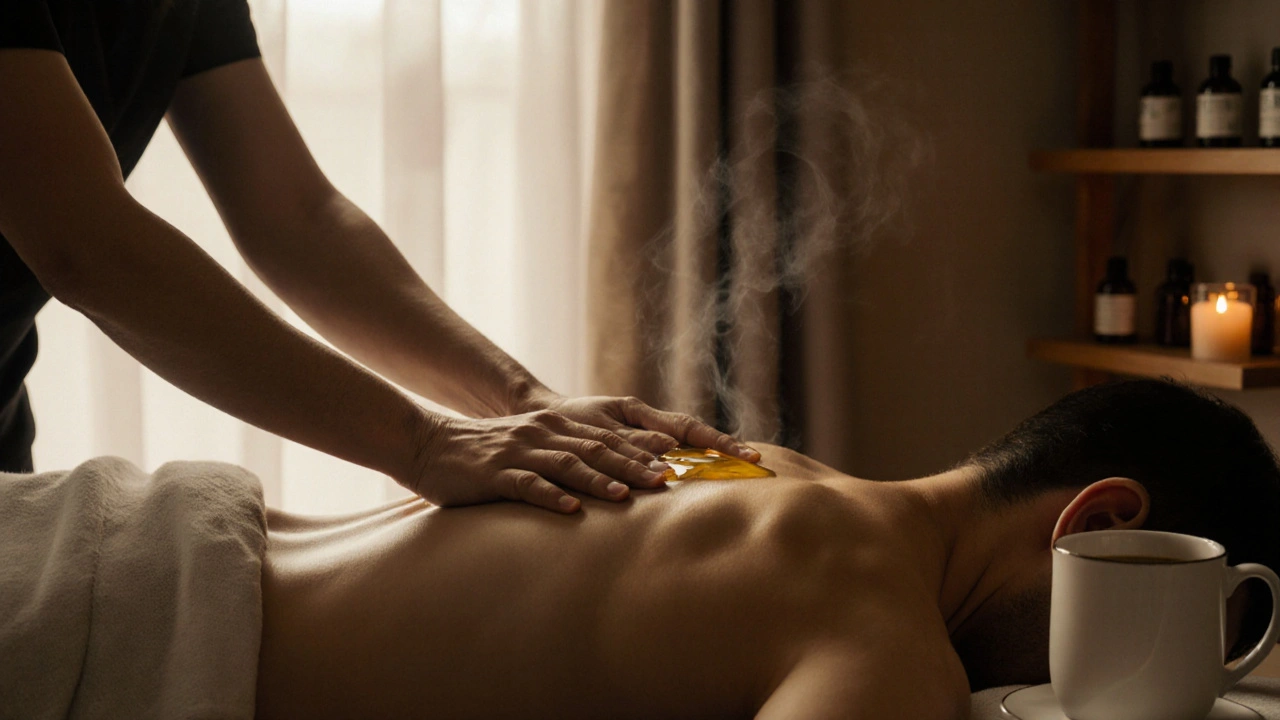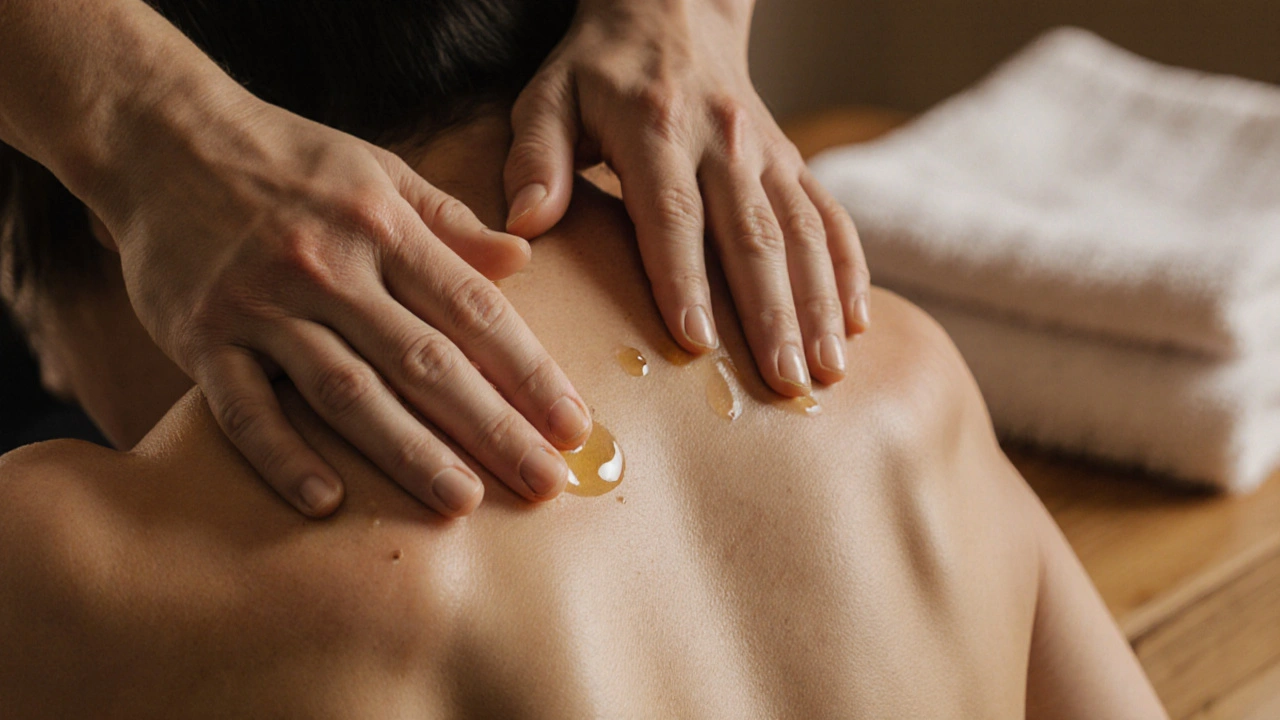Swedish Massage: How It Relaxes Your Body and Mind
 Nov, 18 2025
Nov, 18 2025
Think of the last time you felt truly relaxed-no tension in your shoulders, no tightness in your jaw, no mental noise. That’s not a fantasy. It’s what a proper Swedish massage can do, and it’s not magic. It’s science, touch, and rhythm working together.
What Exactly Is Swedish Massage?
Swedish massage is the most common type of massage therapy in the Western world. It’s not just about rubbing your back. It’s a system of five specific techniques designed to relax muscles, improve circulation, and calm the nervous system. Developed in the 18th century by Dutch physician Petrus Hendrik Ling, it’s based on Western anatomy and physiology, not ancient Eastern traditions. That’s why it feels so familiar-it’s built for the modern human body.
The five core strokes are:
- Effleurage-long, gliding strokes that warm up the muscles and spread massage oil.
- Petrissage-kneading and lifting motions that release deep muscle tension.
- Friction-deep, circular pressure applied to knots or stiff areas.
- Tapotement-rhythmic tapping or cupping that stimulates circulation.
- Vibration-shaking or trembling movements that help loosen tight tissue.
These aren’t random moves. They follow a sequence: start light to warm up, go deeper to release, then return to light to soothe. A good therapist doesn’t just apply pressure-they read your body’s response and adjust.
Why It Works: The Science Behind the Relaxation
When you lie down for a Swedish massage, your body doesn’t just feel good-it changes. Studies from the Journal of Clinical Psychiatry show that a single 60-minute session can lower cortisol levels by up to 31%. Cortisol is your main stress hormone. When it drops, your heart rate slows, your blood pressure eases, and your muscles stop holding onto tension like a clenched fist.
At the same time, serotonin and dopamine-your brain’s natural feel-good chemicals-rise. That’s why people often feel calm, even a little euphoric, after a session. It’s not just a placebo. It’s measurable. One 2023 trial with 120 office workers found that those who received weekly Swedish massages for eight weeks reported 42% less chronic neck and shoulder pain and improved sleep quality.
And it’s not just about muscles. The long, flowing strokes stimulate the lymphatic system, helping your body flush out metabolic waste and toxins. That’s why some people feel slightly tired after a session-it’s not the massage being too intense. It’s your body doing its cleanup job.
What You Can Expect During a Session
Most sessions last 60 to 90 minutes. You’ll be asked to undress to your comfort level-most people keep their underwear on. You’ll be covered with a sheet the whole time, only the area being worked on is exposed. The room is warm, the lights are low, and soft music plays. No loud chatter. No pressure to talk.
The therapist will start with your back, then move to your legs, arms, neck, and scalp. If you have a tight spot-say, your right shoulder from typing all day-tell them. They’ll spend extra time there. A good massage isn’t about hitting every spot. It’s about listening to what your body needs.
Oil or lotion is used to reduce friction. Most places use unscented or lightly lavender-scented oils. If you’re sensitive to smells, ask ahead. Some people even bring their own oil if they have allergies.
It’s not supposed to hurt. If you feel sharp pain, speak up. Swedish massage should feel like a deep, soothing release-not a torture session. A little discomfort is normal when working on knots, but pain means something’s wrong.
Who Benefits the Most?
Swedish massage isn’t just for people with jobs that involve sitting at desks. It helps:
- Parents juggling kids and chores-reduces tension headaches and fatigue
- People recovering from injury-improves blood flow to healing tissues
- Those with anxiety or insomnia-calms the nervous system without medication
- Athletes-helps with recovery between workouts
- Anyone feeling emotionally drained-gives your mind a break from constant thinking
It’s not a cure for chronic pain or serious medical conditions. But if you’re tired of relying on painkillers or scrolling through calming apps, this is one of the few things that actually rewires your body’s stress response.

What It Doesn’t Do
Swedish massage isn’t deep tissue therapy. If you have a herniated disc, severe arthritis, or recent surgery, you need a different approach. It’s also not a replacement for physical therapy or medical treatment.
Don’t expect it to “break up” scar tissue or realign your spine. That’s not how it works. It doesn’t use force. It uses rhythm, pressure, and timing to help your body relax into release.
And it’s not a luxury. It’s a tool. One you can use regularly. Many people start with monthly sessions and move to biweekly or even weekly as they notice the difference.
How Often Should You Get One?
There’s no one-size-fits-all answer, but here’s what works for most people:
- For stress relief: Once every 2-4 weeks
- For chronic tension: Once every 1-2 weeks
- For recovery after intense activity: Within 48 hours after a long hike, race, or heavy workout
Some people swear by getting one every Sunday night. It’s like hitting a reset button before the week starts. Others wait until they feel overwhelmed. The key is consistency. One session gives you a glimpse. Regular sessions retrain your body to stay relaxed.
What to Do After Your Massage
Don’t jump into your car and drive home right away. Give yourself 10-15 minutes to sit quietly. Drink a glass of water. Your body is flushing out toxins-hydration helps.
Avoid caffeine or alcohol for a few hours. They can interfere with the relaxation response.
Take a warm shower if you want. It helps the oils absorb and keeps your muscles loose. Don’t do anything strenuous that day. Let your body stay calm.
Some people feel a little sore the next day, especially if they haven’t had a massage in a while. That’s normal. It’s like the difference between a light jog and a marathon. Your muscles are waking up.

Where to Find a Good Therapist
Look for someone certified by a recognized body like the Australian Association of Massage Therapists or Associated Bodywork & Massage Professionals. Ask if they specialize in Swedish massage-not just “massage.” Some therapists mix styles, which can be great, but if you want the classic experience, make sure they know the five strokes inside out.
Read reviews that mention relaxation, not just “it felt good.” Look for phrases like “I fell asleep,” “I felt lighter,” or “I didn’t want to leave.” That’s the real sign of a good session.
Don’t be afraid to try a few. A massage is personal. The right therapist feels like a quiet, skilled guide-not a salesperson.
Can You Do It at Home?
You can’t fully replicate a professional Swedish massage at home. But you can get close. Use a foam roller for your back, a tennis ball for your feet, and a good oil. Spend 10 minutes a day on long, slow strokes-especially on your neck, shoulders, and calves. Focus on breathing. Let your hands move slowly. It’s not about pressure. It’s about presence.
One study from the University of Miami found that people who did 10 minutes of self-massage daily for four weeks reported a 27% drop in perceived stress levels. It’s not a replacement for a professional session, but it’s a powerful daily habit.
Final Thought: It’s Not Just a Treatment. It’s a Reset.
Swedish massage isn’t about fixing what’s broken. It’s about reminding your body how to relax. In a world that never stops asking for more-more productivity, more speed, more output-it’s one of the few things that says: stop.
You don’t need to be injured. You don’t need to be in pain. You just need to be tired. And that’s enough.
Is Swedish massage painful?
No, Swedish massage should not be painful. It uses gentle to moderate pressure, focusing on relaxation, not deep tissue work. If you feel sharp pain, tell your therapist. Discomfort can happen with tight knots, but pain means the pressure is too much.
How long does a Swedish massage session last?
Most sessions last 60 or 90 minutes. A 60-minute session covers the full body with good attention to key areas. A 90-minute session allows for deeper work and more time on problem areas like the neck or lower back.
Do I need to undress completely?
No. You undress to your comfort level. Most people keep their underwear on. You’ll be covered with a sheet the entire time, and only the area being worked on is exposed. Your privacy is always respected.
Can I get a Swedish massage if I’m pregnant?
Yes, but only with a therapist trained in prenatal massage. Regular Swedish massage is safe after the first trimester, but pressure points and positioning need to be adjusted. Always inform your therapist you’re pregnant before the session.
How soon will I feel the benefits?
You’ll feel calmer immediately after the session. Muscle tension eases within hours. For lasting effects-like better sleep or reduced chronic pain-most people notice changes after 3-4 regular sessions spaced a week or two apart.
Is Swedish massage covered by health insurance?
In some cases, yes. If you have an extended health plan with massage therapy coverage, Swedish massage is often included. You’ll need a referral from a doctor or practitioner in some regions. Check your policy details or ask your provider.
